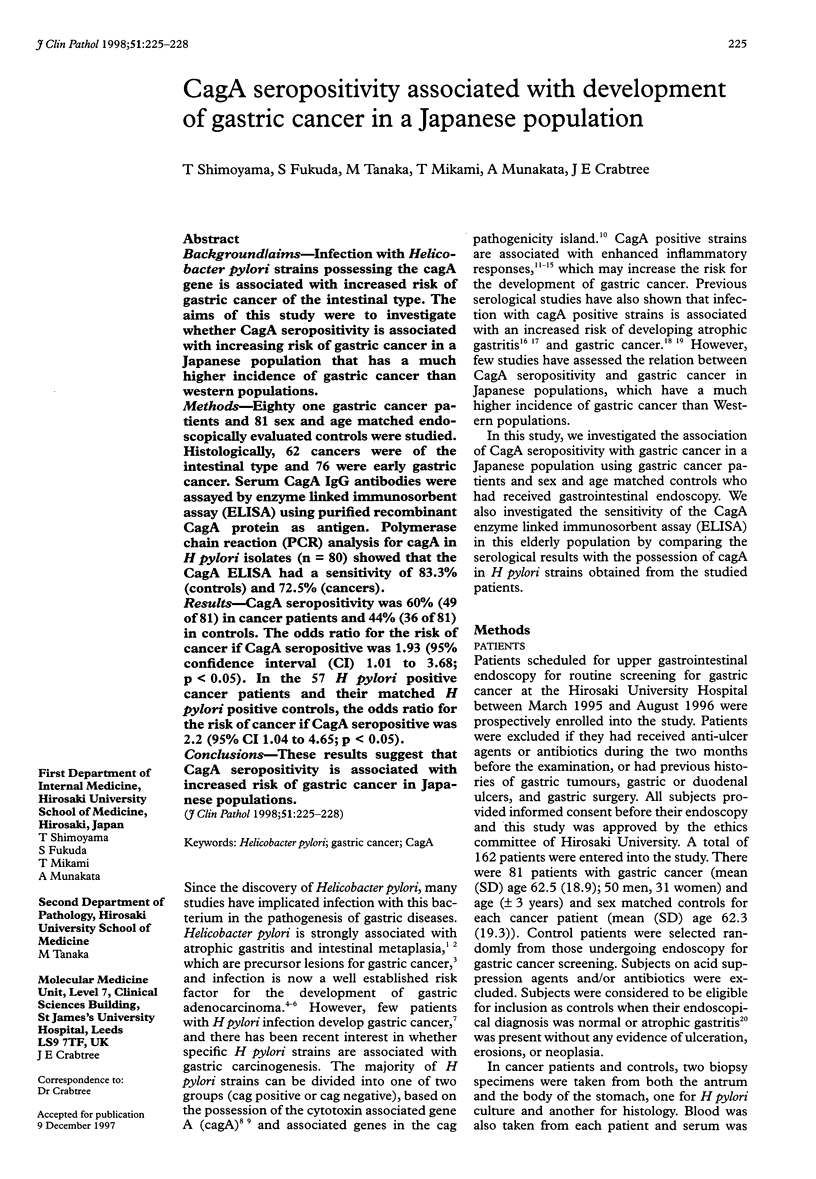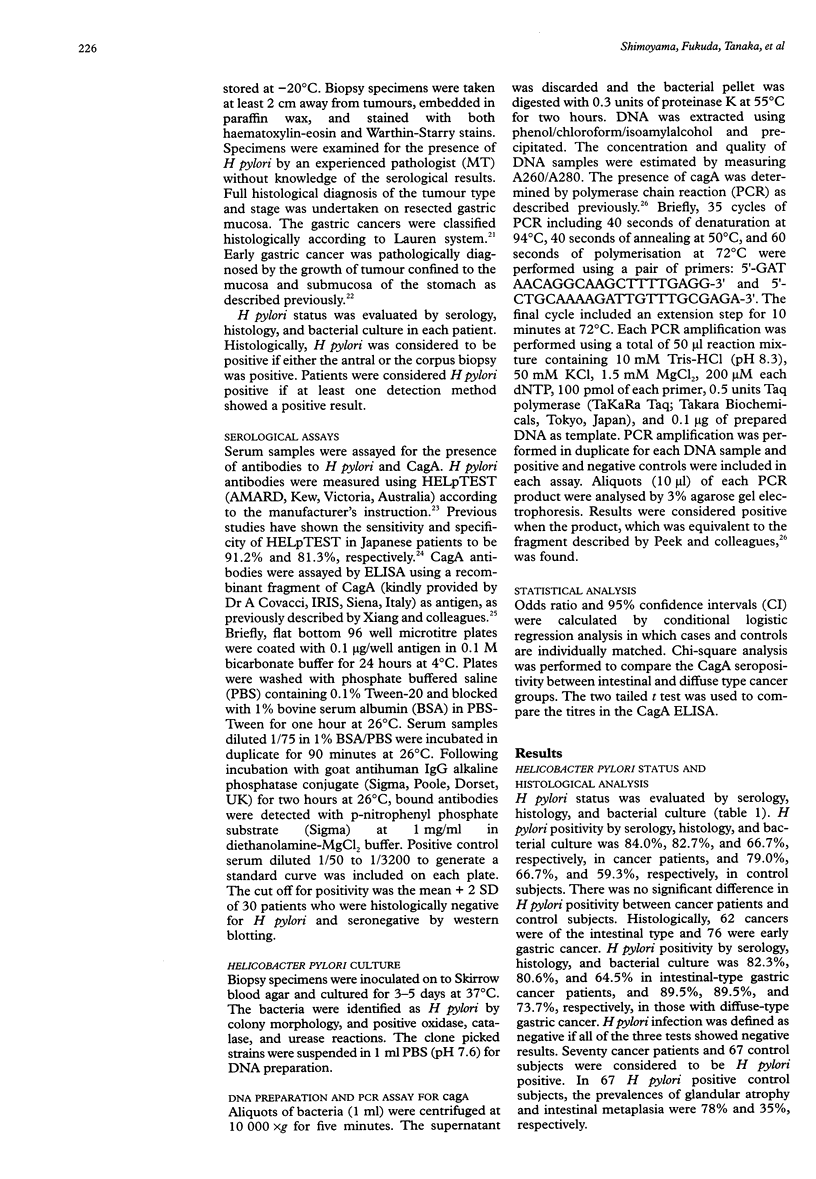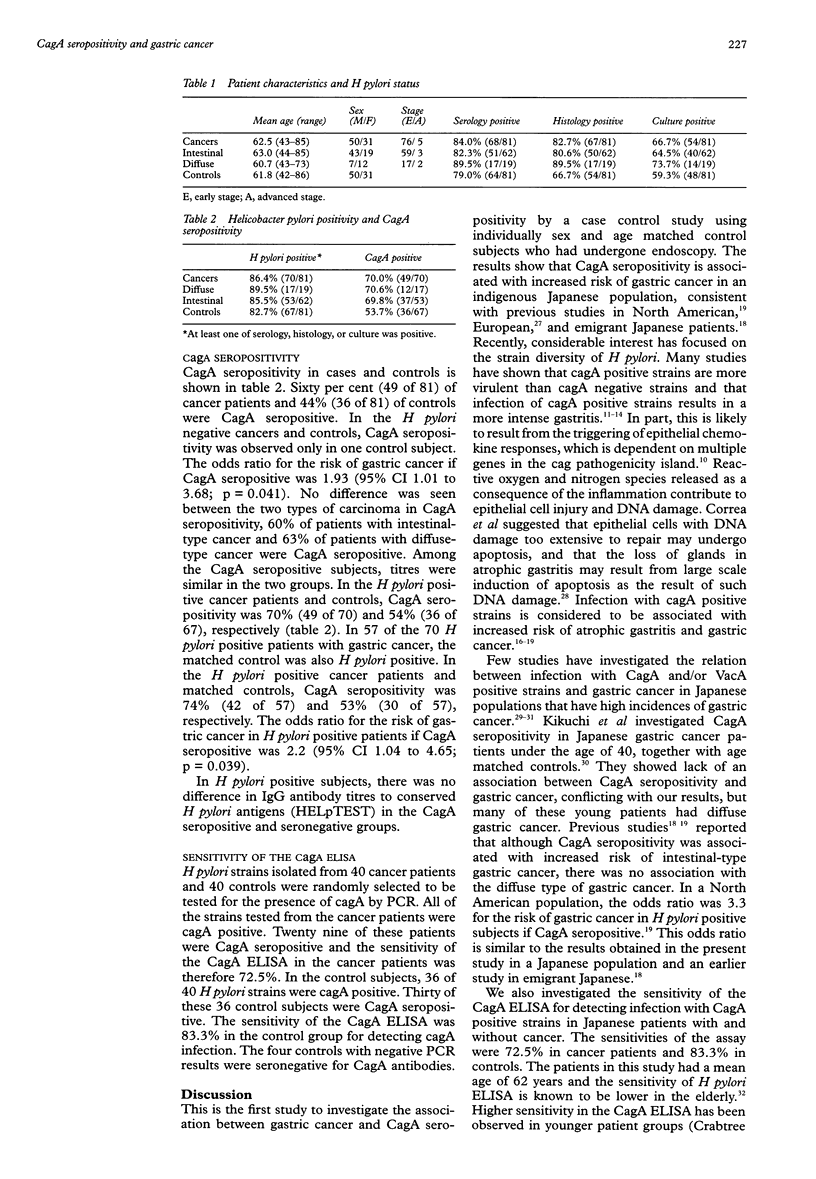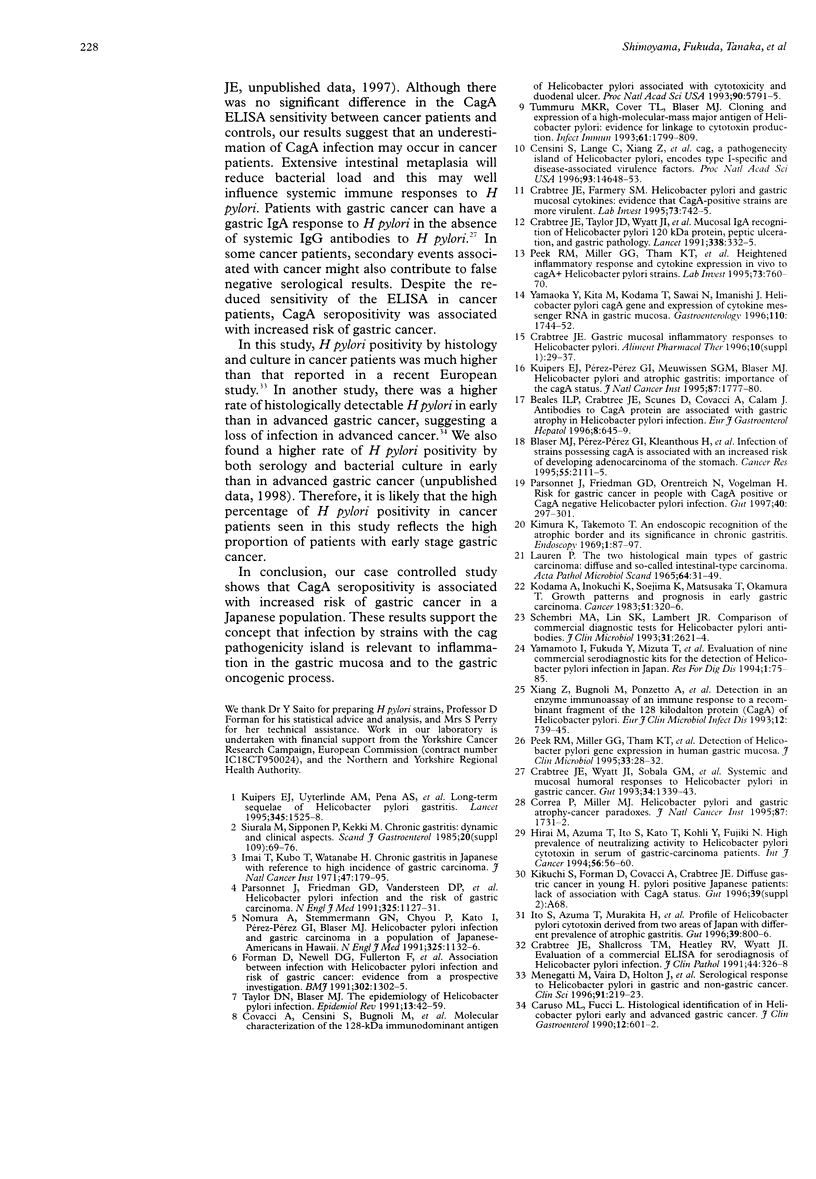Abstract
BACKGROUND/AIMS: Infection with Helicobacter pylori strains possessing the cagA gene is associated with increased risk of gastric cancer of the intestinal type. The aims of this study were to investigate whether CagA seropositivity is associated with increasing risk of gastric cancer in a Japanese population that has a much higher incidence of gastric cancer than western populations. METHODS: Eighty one gastric cancer patients and 81 sex and age matched endoscopically evaluated controls were studied. Histologically, 62 cancers were of the intestinal type and 76 were early gastric cancer. Serum CagA IgG antibodies were assayed by enzyme linked immunosorbent assay (ELISA) using purified recombinant CagA protein as antigen. Polymerase chain reaction (PCR) analysis for cagA in H pylori isolates (n = 80) showed that the CagA ELISA had a sensitivity of 83.3% (controls) and 72.5% (cancers). RESULTS: CagA seropositivity was 60% (49 of 81) in cancer patients and 44% (36 of 81) in controls. The odds ratio for the risk of cancer if CagA seropositive was 1.93 (95% confidence interval (CI) 1.01 to 3.68; p < 0.05). In the 57 H pylori positive cancer patients and their matched H pylori positive controls, the odds ratio for the risk of cancer if CagA seropositive was 2.2 (95% CI 1.04 to 4.65; p < 0.05). CONCLUSIONS: These results suggest that CagA seropositivity is associated with increased risk of gastric cancer in Japanese populations.
Full text
PDF



Selected References
These references are in PubMed. This may not be the complete list of references from this article.
- Beales I. L., Crabtree J. E., Scunes D., Covacci A., Calam J. Antibodies to CagA protein are associated with gastric atrophy in Helicobacter pylori infection. Eur J Gastroenterol Hepatol. 1996 Jul;8(7):645–649. [PubMed] [Google Scholar]
- Blaser M. J., Perez-Perez G. I., Kleanthous H., Cover T. L., Peek R. M., Chyou P. H., Stemmermann G. N., Nomura A. Infection with Helicobacter pylori strains possessing cagA is associated with an increased risk of developing adenocarcinoma of the stomach. Cancer Res. 1995 May 15;55(10):2111–2115. [PubMed] [Google Scholar]
- Caruso M. L., Fucci L. Histological identification of Helicobacter pylori in early and advanced gastric cancer. J Clin Gastroenterol. 1990 Oct;12(5):601–602. [PubMed] [Google Scholar]
- Censini S., Lange C., Xiang Z., Crabtree J. E., Ghiara P., Borodovsky M., Rappuoli R., Covacci A. cag, a pathogenicity island of Helicobacter pylori, encodes type I-specific and disease-associated virulence factors. Proc Natl Acad Sci U S A. 1996 Dec 10;93(25):14648–14653. doi: 10.1073/pnas.93.25.14648. [DOI] [PMC free article] [PubMed] [Google Scholar]
- Correa P., Miller M. J. Helicobacter pylori and gastric atrophy--cancer paradoxes. J Natl Cancer Inst. 1995 Dec 6;87(23):1731–1732. doi: 10.1093/jnci/87.23.1731. [DOI] [PubMed] [Google Scholar]
- Covacci A., Censini S., Bugnoli M., Petracca R., Burroni D., Macchia G., Massone A., Papini E., Xiang Z., Figura N. Molecular characterization of the 128-kDa immunodominant antigen of Helicobacter pylori associated with cytotoxicity and duodenal ulcer. Proc Natl Acad Sci U S A. 1993 Jun 15;90(12):5791–5795. doi: 10.1073/pnas.90.12.5791. [DOI] [PMC free article] [PubMed] [Google Scholar]
- Crabtree J. E., Farmery S. M. Helicobacter pylori and gastric mucosal cytokines: evidence that CagA-positive strains are more virulent. Lab Invest. 1995 Dec;73(6):742–745. [PubMed] [Google Scholar]
- Crabtree J. E. Gastric mucosal inflammatory responses to Helicobacter pylori. Aliment Pharmacol Ther. 1996 Apr;10 (Suppl 1):29–37. doi: 10.1046/j.1365-2036.1996.22164003.x. [DOI] [PubMed] [Google Scholar]
- Crabtree J. E., Taylor J. D., Wyatt J. I., Heatley R. V., Shallcross T. M., Tompkins D. S., Rathbone B. J. Mucosal IgA recognition of Helicobacter pylori 120 kDa protein, peptic ulceration, and gastric pathology. Lancet. 1991 Aug 10;338(8763):332–335. doi: 10.1016/0140-6736(91)90477-7. [DOI] [PubMed] [Google Scholar]
- Crabtree J. E., Wyatt J. I., Sobala G. M., Miller G., Tompkins D. S., Primrose J. N., Morgan A. G. Systemic and mucosal humoral responses to Helicobacter pylori in gastric cancer. Gut. 1993 Oct;34(10):1339–1343. doi: 10.1136/gut.34.10.1339. [DOI] [PMC free article] [PubMed] [Google Scholar]
- Forman D., Newell D. G., Fullerton F., Yarnell J. W., Stacey A. R., Wald N., Sitas F. Association between infection with Helicobacter pylori and risk of gastric cancer: evidence from a prospective investigation. BMJ. 1991 Jun 1;302(6788):1302–1305. doi: 10.1136/bmj.302.6788.1302. [DOI] [PMC free article] [PubMed] [Google Scholar]
- Hirai M., Azuma T., Ito S., Kato T., Kohli Y., Fujiki N. High prevalence of neutralizing activity to Helicobacter pylori cytotoxin in serum of gastric-carcinoma patients. Int J Cancer. 1994 Jan 2;56(1):56–60. doi: 10.1002/ijc.2910560111. [DOI] [PubMed] [Google Scholar]
- Imai T., Kubo T., Watanabe H. Chronic gastritis in Japanese with reference to high incidence of gastric carcinoma. J Natl Cancer Inst. 1971 Jul;47(1):179–195. [PubMed] [Google Scholar]
- Ito S., Azuma T., Murakita H., Hirai M., Miyaji H., Ito Y., Ohtaki Y., Yamazaki Y., Kuriyama M., Keida Y. Profile of Helicobacter pylori cytotoxin derived from two areas of Japan with different prevalence of atrophic gastritis. Gut. 1996 Dec;39(6):800–806. doi: 10.1136/gut.39.6.800. [DOI] [PMC free article] [PubMed] [Google Scholar]
- Kodama Y., Inokuchi K., Soejima K., Matsusaka T., Okamura T. Growth patterns and prognosis in early gastric carcinoma. Superficially spreading and penetrating growth types. Cancer. 1983 Jan 15;51(2):320–326. doi: 10.1002/1097-0142(19830115)51:2<320::aid-cncr2820510226>3.0.co;2-#. [DOI] [PubMed] [Google Scholar]
- Kuipers E. J., Pérez-Pérez G. I., Meuwissen S. G., Blaser M. J. Helicobacter pylori and atrophic gastritis: importance of the cagA status. J Natl Cancer Inst. 1995 Dec 6;87(23):1777–1780. doi: 10.1093/jnci/87.23.1777. [DOI] [PubMed] [Google Scholar]
- Kuipers E. J., Uyterlinde A. M., Peña A. S., Roosendaal R., Pals G., Nelis G. F., Festen H. P., Meuwissen S. G. Long-term sequelae of Helicobacter pylori gastritis. Lancet. 1995 Jun 17;345(8964):1525–1528. doi: 10.1016/s0140-6736(95)91084-0. [DOI] [PubMed] [Google Scholar]
- LAUREN P. THE TWO HISTOLOGICAL MAIN TYPES OF GASTRIC CARCINOMA: DIFFUSE AND SO-CALLED INTESTINAL-TYPE CARCINOMA. AN ATTEMPT AT A HISTO-CLINICAL CLASSIFICATION. Acta Pathol Microbiol Scand. 1965;64:31–49. doi: 10.1111/apm.1965.64.1.31. [DOI] [PubMed] [Google Scholar]
- Menegatti M., Vaira D., Holton J., Miranda F., Ricci C., Gusmaroli R., Ainley C., Miglioli M., Barbara L. Serological response to Helicobacter pylori in gastric and non-gastric cancer. Clin Sci (Lond) 1996 Aug;91(2):219–223. doi: 10.1042/cs0910219. [DOI] [PubMed] [Google Scholar]
- Parsonnet J., Friedman G. D., Orentreich N., Vogelman H. Risk for gastric cancer in people with CagA positive or CagA negative Helicobacter pylori infection. Gut. 1997 Mar;40(3):297–301. doi: 10.1136/gut.40.3.297. [DOI] [PMC free article] [PubMed] [Google Scholar]
- Parsonnet J., Friedman G. D., Vandersteen D. P., Chang Y., Vogelman J. H., Orentreich N., Sibley R. K. Helicobacter pylori infection and the risk of gastric carcinoma. N Engl J Med. 1991 Oct 17;325(16):1127–1131. doi: 10.1056/NEJM199110173251603. [DOI] [PubMed] [Google Scholar]
- Peek R. M., Jr, Miller G. G., Tham K. T., Perez-Perez G. I., Zhao X., Atherton J. C., Blaser M. J. Heightened inflammatory response and cytokine expression in vivo to cagA+ Helicobacter pylori strains. Lab Invest. 1995 Dec;73(6):760–770. [PubMed] [Google Scholar]
- Peek R. M., Jr, Miller G. G., Tham K. T., Pérez-Pérez G. I., Cover T. L., Atherton J. C., Dunn G. D., Blaser M. J. Detection of Helicobacter pylori gene expression in human gastric mucosa. J Clin Microbiol. 1995 Jan;33(1):28–32. doi: 10.1128/jcm.33.1.28-32.1995. [DOI] [PMC free article] [PubMed] [Google Scholar]
- Schembri M. A., Lin S. K., Lambert J. R. Comparison of commercial diagnostic tests for Helicobacter pylori antibodies. J Clin Microbiol. 1993 Oct;31(10):2621–2624. doi: 10.1128/jcm.31.10.2621-2624.1993. [DOI] [PMC free article] [PubMed] [Google Scholar]
- Siurala M., Sipponen P., Kekki M. Chronic gastritis: dynamic and clinical aspects. Scand J Gastroenterol Suppl. 1985;109:69–76. doi: 10.3109/00365528509103939. [DOI] [PubMed] [Google Scholar]
- Tummuru M. K., Cover T. L., Blaser M. J. Cloning and expression of a high-molecular-mass major antigen of Helicobacter pylori: evidence of linkage to cytotoxin production. Infect Immun. 1993 May;61(5):1799–1809. doi: 10.1128/iai.61.5.1799-1809.1993. [DOI] [PMC free article] [PubMed] [Google Scholar]
- Yamaoka Y., Kita M., Kodama T., Sawai N., Imanishi J. Helicobacter pylori cagA gene and expression of cytokine messenger RNA in gastric mucosa. Gastroenterology. 1996 Jun;110(6):1744–1752. doi: 10.1053/gast.1996.v110.pm8964399. [DOI] [PubMed] [Google Scholar]


